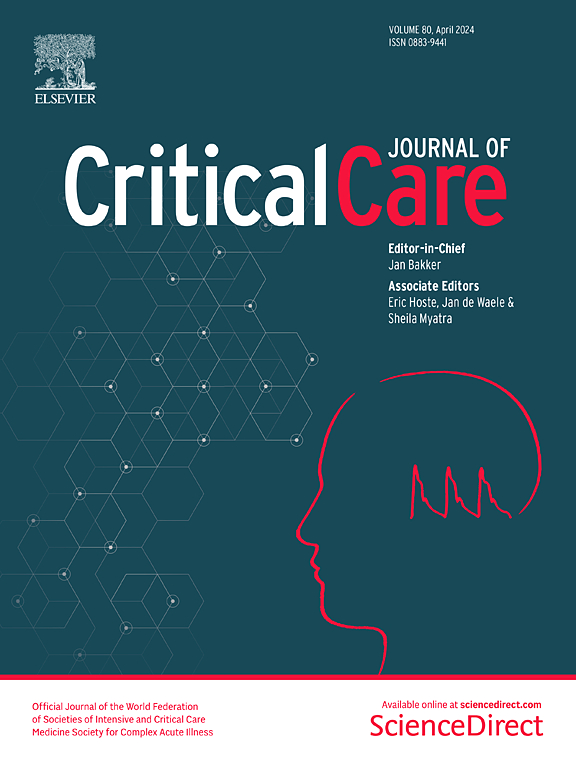儿童外伤性脑损伤后动态脑顺应性监测的价值:STARSHIP研究亚分析
IF 8.8
1区 医学
Q1 CRITICAL CARE MEDICINE
引用次数: 0
摘要
脑顺应性描述了颅内空间内的压力-容积关系,量化了颅内压力(ICP)显著升高前大脑适应容积变化的能力。脉冲形状指数- psi -将ICP脉冲波配置分为4类,代表递增的合规状态。在本分析中,我们在前瞻性收集的儿童TBI患者队列中探讨了与结果、生理参数和个体ICP损伤相关的指标。前瞻性观察性STARSHIP研究获得的数据包括临床信息、12个月的结果和来自英国10个儿科重症监护病房的98名儿童TBI患者的监测数据。使用单变量和多变量分析计算和比较PSI,并考虑它们的时间趋势和与个体ICP损伤的关系。PSI衍生指标与单变量分析的结果相关,此外,它们与ICP和更差的脑血管反应性相关(所描述指标的绝对相关系数接近0.3)。交叉相关分析显示,PSI变化后ICP变化的中位延迟为8 min(95%置信区间为7.6 ~ 8.5 min)。ICP升高前较高的PSI值与随后的ICP损伤持续时间更长、程度更大相关。此外,渗透治疗前较高的PSI和渗透治疗后更快的PSI下降与成功降低ICP有关。PSI通过动态评估大脑依从性来增强儿科TBI的床边监测。PSI的变化似乎先于随后的ICP损伤,并与其严重程度相关,因此可能有助于及时干预。此外,在进行渗透治疗前评估PSI水平可以衡量治疗成功与否。本文章由计算机程序翻译,如有差异,请以英文原文为准。
The value of dynamic cerebral compliance monitoring after pediatric traumatic brain injury: a STARSHIP study sub-analysis
Cerebral compliance describes the pressure–volume relationship within the intracranial space, quantifying the brain’s capacity to accommodate changes in volume before significant increases in intracranial pressure (ICP) occur. The pulse shape index – PSI—classifies the ICP pulse-wave-configuration into 4 categories representing the incremental state of compliance. In this analysis we explore the metric in a cohort of prospectively collected pediatric TBI patients in relation to outcome, physiological parameters, and individual ICP insults. Data acquired by the prospective observational STARSHIP study which included clinical information, 12-month outcome, and monitoring data from 98 pediatric TBI patients admitted to 10 pediatric intensive care units across the UK was assessed. PSI was calculated and compared using univariable and multivariable analyses, as well as considering their time-trends and relation to individual ICP insults. PSI derived metrics were associated with outcomes within univariable analyses, additionally they were associated with ICP, and worse cerebrovascular reactivity (absolute correlation coefficients close to 0.3 for the described metrics). Cross correlation analysis revealed a median delay of 8 min for changes in ICP after changes in PSI (95% confidence interval of 7.6 to 8.5 min). Higher PSI value before ICP elevations was associated with longer duration and greater magnitude of subsequent ICP insults. Additionally, higher PSI before and faster decrease in PSI after osmotherapy were associated with successful reduction of ICP. PSI enhances bedside monitoring of pediatric TBI by enabling dynamic assessment of cerebral compliance. Variations in PSI appear to precede subsequent ICP insults and are associated with their severity, thereby potentially facilitating timely interventions. Furthermore, assessing the PSI level before administering osmotherapy may allow gauging treatment success.
求助全文
通过发布文献求助,成功后即可免费获取论文全文。
去求助
来源期刊

Critical Care
医学-危重病医学
CiteScore
20.60
自引率
3.30%
发文量
348
审稿时长
1.5 months
期刊介绍:
Critical Care is an esteemed international medical journal that undergoes a rigorous peer-review process to maintain its high quality standards. Its primary objective is to enhance the healthcare services offered to critically ill patients. To achieve this, the journal focuses on gathering, exchanging, disseminating, and endorsing evidence-based information that is highly relevant to intensivists. By doing so, Critical Care seeks to provide a thorough and inclusive examination of the intensive care field.
 求助内容:
求助内容: 应助结果提醒方式:
应助结果提醒方式:


